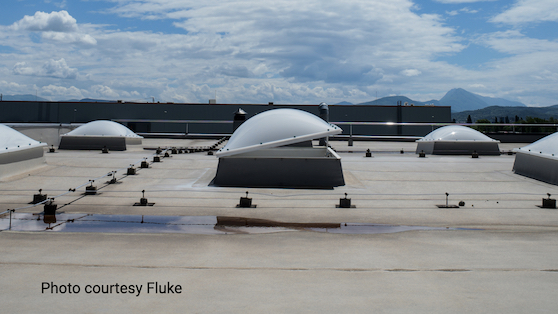
Energy Efficiency
Features
Get ahead of flat roof moisture intrusion and reduce exposure to molds
Better to catch an emerging issue before it becomes a destructive—and possibly mold-ridden—problem.
May 19, 2021 By Aaron Woody
 Preparing to test for rooftop moisture intrusion using a professional infrared camera. Photo courtesy Fluke.
Preparing to test for rooftop moisture intrusion using a professional infrared camera. Photo courtesy Fluke. May 19, 2021 – The Centers for Disease Control & Prevention (CDC, in the U.S.) reminds us that mold is found both indoors and outdoors, and can enter our indoor environments any number of ways—through open doorways, windows, vents and HVAC systems, or by attaching itself to clothing, shoes and pets. This is normal.
However, when allowed to drop into locations with excessive moisture—e.g. where leakage may have occurred in roofs, pipes, walls and plant pots, or where there has been flooding—mold spores will reproduce, and become a concern to both building and home owners.
“Many building materials provide suitable nutrients that encourage mold to grow. Wet cellulose materials, including paper and paper products, cardboard, ceiling tiles, wood, and wood products, are particularly conducive for the growth of some molds,” CDC writes. “Other materials, such as dust, paints, wallpaper, insulation materials, drywall, carpet, fabric and upholstery commonly support mold growth.”
Some people are sensitive to molds, and may only get a stuffy nose or itchy eyes, but others—like those with allergies to molds or who have asthma—may suffer more intense reactions, like fever and shortness of breath, the CDC warns.
According to the U.S. Environmental Protection Agency, there is no practical way to eliminate mold spores in an indoor environment. Thus, the best way to control mold growth—which can occur in as little as 24 hours—is to control moisture.
Whether at an industrial plant, in a commercial office or residence, frequent inspections of the building envelope and the environmental conditions inside are important for detecting and dealing with excessive moisture so as to maintain a healthy structure—not to mention a more energy–efficient structure.
Roof inspections
Normally, there is little or no water within a flat roof assembly. When a leak develops, water enters the assembly and, depending on the type of insulation system, is either absorbed by the insulation or runs to the cracks between the non-absorbent insulation. When water enters the roof assembly, it is there for a long time—sometimes for the life of the roof.

Residual moisture on a commercial rooftop after a rainstorm. Photo courtesy Fluke.
A physical property of any material is its thermal capacitance; that is, its ability to store heat. The materials in roof assemblies have relatively low thermal capacitance, especially when compared to water. Water requires a lot of energy to raise its temperature and, likewise, must release a lot of energy to cool.
We can exploit these natural physical properties when performing thermal roof inspections for determining the condition of our roof. Dry roof insulation heats up and cools down faster than wet roof insulation.
But infrared inspection goes beyond simply finding a leak; we want to uncover the extent of moisture invasion in the insulation.
To do this, we require the solar heating of a sunny day. Then, after the sun goes down and the roof surface begins to cool, the dry roof insulation will cool faster than the wet. As a result, the moisture-soaked roof areas appear quite clearly when performing an infrared scan.
(Any moisture present in roofs and walls can be detected with a sensitive infrared camera, under the right conditions, but the most effective infrared roof inspections are performed after sunset, when the roof gives off its heat energy accumulated during the day.)
Similarly, it is possible to detect moisture located behind interior walls with an infrared camera, under the right conditions. The temperature difference created by the presence of moisture on the inside surface of a wall will appear differently than the surrounding area.
Perfect timing
It is important to pick the optimal time for testing and to maintain proper temperature control. Keep in mind that the greater the difference in temperature between outside and inside the building envelope, the better the thermal results. To ensure a successful thermal test, therefore, adjust your investigation to accommodate weather conditions.
• A warm/hot climate is excellent for thermal investigations since air-conditioning is cooling the building interior. The water used in testing also tends to be cooler, creating greater variance in temperature and, therefore, generating better thermal images.
• Exteriors such as stucco are more porous, absorbing and retaining moisture, providing better exterior shots than siding, which hides water behind the thick planks. You can also use hot water on a cold exterior, but it is difficult to apply enough to locate the problem.
The type of insulation used on a roof will result in an infrared image that is characteristic of how that insulation absorbs water. Absorbent roof insulation acts like a sponge. The water migrates by capillary action throughout a complete roof board before it jumps to the adjacent board. This results in a checkerboard thermal pattern.
Non-absorbent roof insulation creates a much different pattern when it becomes wet. The water is not absorbed and runs to the edge of the roof board. The water tends to collect at the edges of the boards resulting in a window frame pattern. Different patterns may result from other, less common insulating systems.
Use the same process during the winter; however, winter surveys are more difficult because the temperature differences are usually less than on summer surveys (5 F versus 20 F). If the building is heated, the added heat flow from the building through wet insulation will help enhance the winter thermal patterns.
Inspection for prevention
Flat roof membranes are the waterproof barriers between the outside elements and the interior of buildings, and come in a variety of materials and designs. They must be able to expand and contract, resist high winds and the effects of solar radiation, and withstand foot traffic. It is easy to see why roofs leak.
Considering the abuse to which our flat roofs are subjected year after year, it is prudent to inspect them regularly, even when you don’t suspect a problem. Better to catch an emerging issue before it becomes a destructive—and possibly mold-ridden—problem.
References
• “Basic Facts about Mold and Dampness”, Centers for Disease Control & Prevention. Page last reviewed August 11, 2020.
Aaron Woody is senior product applications manager with Fluke, and possesses 17 years of experience in the process automation and engineering industry.
Print this page